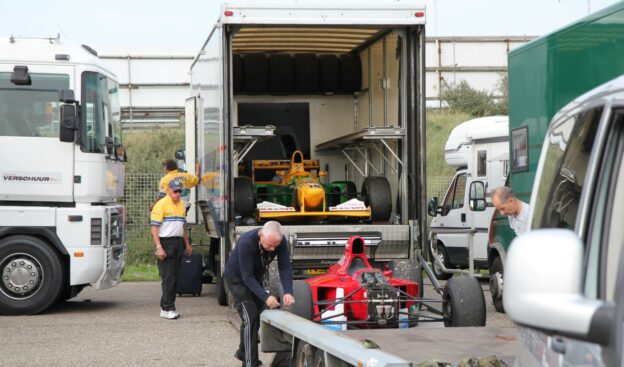Transporting F1 Cars: Challenges and Solutions

Watching F1 cars zoom around the circuit is a thrilling experience. Even more exciting is witnessing how each supercar's tires change in under a minute to maintain lap timings.
However, one curious question remains: how do these Formula One cars get to the race? After all, we never see them driving on public roads to the Grand Prix. What challenges do F1 cars face along the way, and what solutions exist for these hurdles?
Read on to satisfy your curiosity and learn more about this fascinating process.
1. Logistics Planning
Transporting Formula One cars doesn't work the way you would usually ship car to another state. It requires meticulous logistics planning, including selecting appropriate transportation methods and coordinating schedules and routes to ensure timely deliveries. Here's how each of these missions is executed one by one:
Selecting Transportation Methods
One of the most critical decisions when shipping an F1 car is selecting the transportation method. Most of the time, vehicles are shipped across countries using air freight services. This involves securing the sports car in a specialized enclosed car carrier and transporting it in a cargo airplane.
Recently, F1 has shifted to more sustainable transport methods to reduce CO2 emissions by opting for sea freight services. This process is only feasible for non-critical components as it consumes a lot of time.
Moreover, when F1 cars need to be relocated within the same city, they are transported using custom-built trucks. Typically, each Formula One vehicle has its car carrier, which ensures their secure movement from one location to another.
Coordinating Schedules and Routes
Never have we heard of a Formula Car missing a race track due to flight delays. This flawless record results from careful logistics coordination, where teams arrange flexible schedules and optimal routes. Just as they engage in car ship services, these professionals assess efficient routes with minimal traffic to prevent delays or other road challenges.
Ensuring Timely Deliveries
As an avid Formula One fan, you're likely aware of these teams' tightly packed schedules. Consequently, this demands exceptional efficiency to adhere to precise timelines without any margin for error. For this purpose, F1 car deliveries are arranged 7-9 days before each race weekend to ensure everything is in place.
Nevertheless, unforeseen events, such as weather or logistical challenges, can disrupt plans during the Grand Prix or in transit. Despite these potential setbacks, the Formula One teams always have backup plans because the show must go on.
2. Securing Optimal Car Carriers
The process of securing optimal car ship carriers for an F1 begins with:
Identifying Specialized Carriers
F1 cars are transported by air freight across countries and by road when events are organized in Europe. Regardless of the shipping method, custom-built car carriers are always used to ensure the safe transport of these high-performance vehicles.
Let's explore how each transportation method works, and the type of car carrier each of them utilizes:
- Air Freight: F1 vehicles are usually transported swiftly using air freight services. The car carriers used here are designed to fit at least two dismantled race cars. Additionally, the engines, tires, IT racks, and even the fuel are packed in custom-made containers to avoid damage during transit.
- Road Route: When F1 races are scheduled within the same continent, the team selects road routes to deliver the super vehicles. In this case, a tailored car carrier is used to transport the cars along with non-critical parts. However, the F1 team still heavily relies on air freight services for timely deliveries to eliminate potential delays.
Ensuring Compatibility with F1 Car Needs
Securing optimal car carriers involves ensuring that the chosen carriers are compatible with the specific needs of F1 cars. This includes:
- Proper Securing Mechanisms: A car carrier transporting an F1 must have proper securing mechanisms. These might include strap-on belts or even stabilized platforms. Such mechanisms stabilize the vehicles during transit, ensuring they remain secure and undamaged.
- Shock Absorption: F1 cars have extremely low ground clearance, making them susceptible to damage from rough patches along the way. To mitigate this risk, it's crucial to transport these supercars in a car carrier equipped with advanced suspension systems to minimize vibrations and shocks.
3. Cost Analysis: How Much Does It Cost to Ship a Car
Determining how much does it cost to ship a car varies widely based on distance, vehicle make and model, and chosen transport method. However, estimating auto shipping quotes for an F1 car is far more complex than for standard vehicles.
Due to the scale and frequency of operations involved, managing logistics costs in Formula One requires significant investment. Teams continually strive to balance cost efficiency with logistical effectiveness. For example, while air freight ensures rapid delivery, it is more expensive than sea freight, which may suffice for less time-sensitive equipment.
Moreover, cost management in F1 also extends beyond transportation to encompass on-site operations during race events. Efficient equipment setup and teardown are crucial to minimizing time and labor expenses. This demands team coordination to optimize resource utilization and logistical strategies.
4. Dealing with Major State Regulations and Restrictions
With events organized in over 30 countries annually, Formula One travels extensively across the globe. As these supercars journey from one location to another, adhering to destination state regulations becomes paramount. Each state imposes its rules governing the entry of vehicles into its territory.
For instance, some regulations may mandate vehicles to have lower fuel consumption or specific dimensions. To ensure compliance with these regulations, the F1 team engages in careful planning and preparation by:
Understanding Regulatory Requirements
The team meticulously researches and understands each state's specific regulations where races are scheduled. Since these cars lack headlights, taillights, or horns, they are not suited for regular road use.
Therefore, they must adhere to all necessary permits and regulations when utilized on racing tracks. The F1 team diligently manages these requirements, ensuring compliance with the regulatory standards set by each race location.
In most cases, the FIA thoroughly investigates whether the circuit is safe for a race. This inspection is conducted to protect the drivers and on-site fans from any mishaps.
Navigating Legal Compliance
Navigating legal compliance poses a significant challenge for Formula One, particularly concerning transporting various machinery worldwide. Beyond sports cars and engines, Formula One involves transporting a range of equipment that must clear customs in each country. Consequently, a single delay in this process can disrupt the entire event schedule.
The F1 team and their stakeholders enlist brokers specializing in swift legal compliance to eliminate these risks. These experts understand international safety regulations and ensure timely adherence to customs requirements. The team acknowledges that what is acceptable in one country may not be so in another; therefore, they must do their homework carefully.
5. Auto Shipping Quotes and Budget Management
A single entity does not regulate F1. Instead, it involves multiple stakeholders, including teams, sponsors, and race organizers, each contributing to the complex logistics of transporting cars worldwide. This decentralized approach requires careful coordination to obtain accurate auto shipping quotes and manage budgets across various races.
Moreover, the F1 team negotiates with shipping companies and logistics providers to secure competitive rates for transporting their high-value assets. They plan budgets to cover transportation and associated expenses such as customs duties, insurance premiums, and handling fees.
Additionally, sponsors too, play a crucial role in funding these operations, often offsetting substantial logistical expenses. Their financial support enables teams to optimize transport logistics and ensure timely deliveries without compromising performance on the track.
6. Ensuring Safety and Minimizing Risks
Besides planning how to ship car to another state and obtaining apt auto shipping quotes, Formula One's top priority is protecting its high-end vehicles. According to USA Today, an average F1 car costs around $12 to $15 million. Henceforth, even the slightest damage can land the organization in deep trouble.
Every Formula One team member is adept at implementing crucial protective measures to ensure the safe transport of vehicles. Key strategies include:
- Utilizing Customized Car Carriers: The car carriers used by F1 teams are custom-built to accommodate each vehicle precisely. These carriers are equipped with advanced technology to ensure the cars remain stable and secure during transit.
- Employing Safe Packaging: The dismantled car chassis and other components of the supercars are packed cautiously in separate containers.
- Ensuring Advanced Handling: F1 employs skilled experts who know how to handle high-performance vehicles using precision techniques.
- Using Specialized Equipment: Formula One also ensures careful vehicle loading and unloading; they utilize ramps and lifts designed for seamless transitions.
7. Conclusion: Best Practices for Efficient F1 Car Shipments
To sum it up, F1 cars demand thorough planning and demand execution. When choosing an auto shipping partner for Formula One cars, qualities like expertise in handling high-value assets and familiarity with international logistics become crucial.
Nexus Auto Transport exemplifies these qualities, offering specialized services tailored to the unique needs of F1 cars. At Nexus, we know what it takes to handle high-performance cars while maintaining their long-term integrity.
Contact us today for personalized auto shipping quotes, or visit our website to explore more services.
✅ Check out more posts with related topics:













LAST 3 F1 Fan COMMENTS